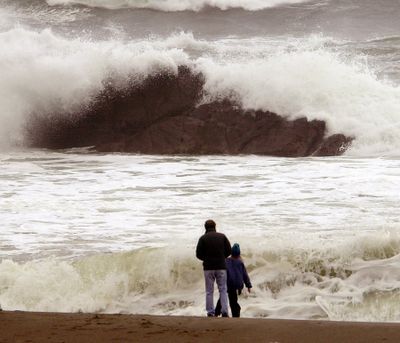Off Oregon’s coast, wave power makes a splash
It’s a prime spot to prospect for new energy source

TILLAMOOK, Ore. — Two years ago, coastal residents had a gold rush on their hands.
Developers, eager to turn wave energy into electricity and certain that Oregon offered a powerhouse resource, laid claim to promising sites from Newport to Coos Bay.
Today, a shakeout is under way. And a county known more for its cheese than its moxie has grabbed a chance to play prospector, not spectator.
Tillamook County officials, noting that the waters off their coast were developer-free, have quietly obtained a permit from federal regulators to study six sites. They picked the spots strategically, essentially blocking development by anyone not to their liking.
“We can either wait until someone runs roughshod over us, or we can make sure we have a say in what happens,” said Paul Levesque, Tillamook County’s chief of staff.
The permit from the Federal Energy Regulatory Commission gives the county the exclusive right to study the six sites. Each stretches seaward three miles from a utility substation that feeds into transmission lines.
County officials acknowledge that jumping into the wave energy debate requires time, money and an inexhaustible patience with state and federal regulators. But, they point out, local influence could bring a huge payoff: jobs for coastal communities, cash for government coffers and a gold-plated reputation for a state out to deepen its green credentials.
The trick, locals say, is to tap the benefits of a new industry without spoiling ocean habitats, economic livelihoods and recreational playgrounds.
The task is daunting. Though there are a few operating wave energy projects in Europe, there are none in the United States. Developers are just beginning to study potential sites along the West and East coasts, and they’re still maneuvering among competing technologies, whether buoy-style or cylinder-shaped. Little is known about the impact on marine life and associated industries or on seabeds and shorelines.
The West Coast, where the Pacific Ocean gathers force for thousands of unobstructed miles before landing, holds far more energy potential than the East Coast, scientists say. Oregon, with accessible seaports and transmission networks and accommodating government policies, is prime territory.
Wave energy projects in Oregon could be generating 500 megawatts of electricity by 2025 or sooner, according to the Wave Energy Trust, a nonprofit that promotes the “responsible development” of ocean energy. That’s about 3 percent of the electricity used by Oregonians today.
Already, regulators are struggling to keep up with development. The process is particularly messy at the federal level, with FERC responsible for projects within three miles of shore and Mineral Management Services the overseer of more distant waters.
“To use nautical terms, I’d describe the regulatory process as ‘confused’ and ‘changeable,’ ” said Des McGinnes, business development manager for Pelamis Wave Power.
The Scotland-based company manufactures a hinged, cylindrical device that moves in the waves to generate electricity — think of a floating string of linked sausages, flexing at the links as waves roll through. (“It looks like a piece of salami with a 16-foot diameter,” said a Tillamook County fisherman.)
A vying technology relies on a high-tech buoy to generate electricity from the up-and-down motion of the waves.
Tillamook County probably will side with the salami. That’s the technology favored by Columbia Energy Partners, the developer the county is expected to hire to carry out the feasibility study and shoulder most of the costs.
Negotiations could include an equity share in any wave energy project that Columbia Energy pursues.
The developer, based in Vancouver, Wash., is best known for its wind energy pursuits. It has yet to tackle the ocean.
Columbia Vice President Jon Norling said his company is particularly interested in two of the six sites, one off Garibaldi and the other off Netarts.
A proposal calls for a 30-megawatt project at each location. That’s not a lot of power — enough to light up about 25,000 to 30,000 homes — but it would establish a foothold, Norling said.
Installation is at least five years away. Already, discussions with fishermen have begun, Norling said.
So have the worries.
Linda Buell owns Garibaldi Charters with her husband, Mick, and co-chairs an advisory committee of fishing interests. She said she appreciates the early discussions with the developer but is concerned about potential conflicts.
At the Garibaldi site, the devices would lie in the middle of important chinook fisheries, she said, and at Netarts, in prime crabbing grounds.
“They can’t just come in here and grab up fishing grounds without offering anything in return,” Buell said.
Everyone hopes to avoid the conflict in Coos County, where New Jersey-based Ocean Power Technologies is pursuing a much larger project — 200 buoys and almost as many megawatts off Coos Bay.
Clusters of buoys would cover a five-mile stretch, north to south, less than three miles from shore.
That’s prime territory for crabbing, said Nick Furman, executive director of the Oregon Dungeness Crab Commission. “That’s five miles of productive habitat we can’t put pots in.”
The conflict erupted early this year when Ocean Power took a plan for a much smaller project and replaced it with the 200-buoy proposal. It’s now scrambling to calm the surprise and anger.
Len Bergstein, a company spokesman, said Ocean Power has taken the gaffe to heart and is working hard to “show we’re relentless in our willingness to sit around the table and discuss this project.”
A 10-buoy project off Reedsport, which is further along and could become commercial in the next year or two, demonstrates the company’s willingness to get along, Bergstein said.
But fishermen aren’t crazy about that one either.
Again, Furman said, “it’s smack dab in the middle of crabbing grounds.
“We feel like we’re struggling to keep up with the process,” he said. “Let’s put the brakes on a little.”